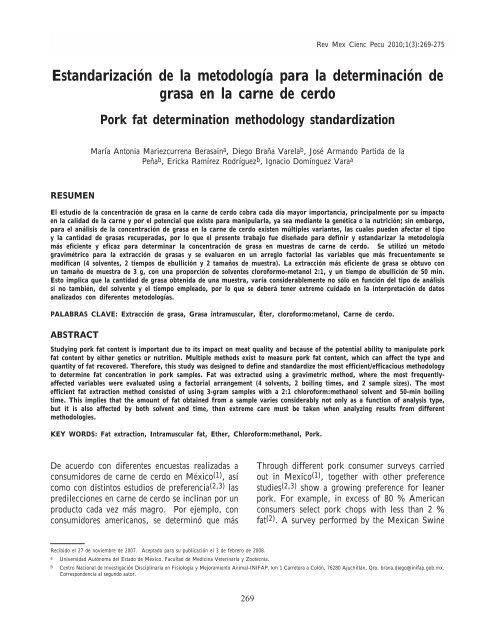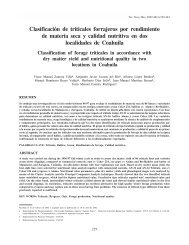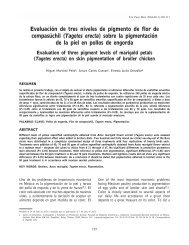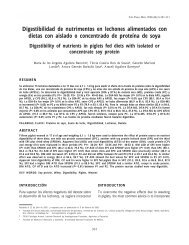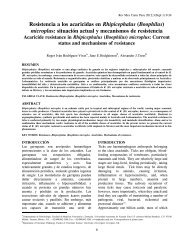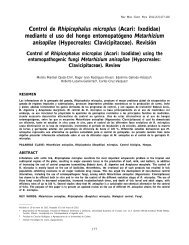Estandarización de la metodología para la determinación de grasa ...
Estandarización de la metodología para la determinación de grasa ...
Estandarización de la metodología para la determinación de grasa ...
Create successful ePaper yourself
Turn your PDF publications into a flip-book with our unique Google optimized e-Paper software.
ESTANDARIZACIÓN DE METODOLOGÍA PARA DETERMINAR GRASA Rev EN Mex CARNE Cienc Pecu DE CERDO 2010;1(3):269-275<br />
<strong>Estandarización</strong> <strong>de</strong> <strong>la</strong> <strong>metodología</strong> <strong>para</strong> <strong>la</strong> <strong>de</strong>terminación <strong>de</strong><br />
<strong>grasa</strong> en <strong>la</strong> carne <strong>de</strong> cerdo<br />
RESUMEN<br />
Pork fat <strong>de</strong>termination methodology standardization<br />
María Antonia Mariezcurrena Berasain a , Diego Braña Vare<strong>la</strong> b , José Armando Partida <strong>de</strong> <strong>la</strong><br />
Peña b , Ericka Ramírez Rodríguez b , Ignacio Domínguez Vara a<br />
El estudio <strong>de</strong> <strong>la</strong> concentración <strong>de</strong> <strong>grasa</strong> en <strong>la</strong> carne <strong>de</strong> cerdo cobra cada día mayor importancia, principalmente por su impacto<br />
en <strong>la</strong> calidad <strong>de</strong> <strong>la</strong> carne y por el potencial que existe <strong>para</strong> manipu<strong>la</strong>r<strong>la</strong>, ya sea mediante <strong>la</strong> genética o <strong>la</strong> nutrición; sin embargo,<br />
<strong>para</strong> el análisis <strong>de</strong> <strong>la</strong> concentración <strong>de</strong> <strong>grasa</strong> en <strong>la</strong> carne <strong>de</strong> cerdo existen múltiples variantes, <strong>la</strong>s cuales pue<strong>de</strong>n afectar el tipo<br />
y <strong>la</strong> cantidad <strong>de</strong> <strong>grasa</strong>s recuperadas, por lo que el presente trabajo fue diseñado <strong>para</strong> <strong>de</strong>finir y estandarizar <strong>la</strong> <strong>metodología</strong><br />
más eficiente y eficaz <strong>para</strong> <strong>de</strong>terminar <strong>la</strong> concentración <strong>de</strong> <strong>grasa</strong> en muestras <strong>de</strong> carne <strong>de</strong> cerdo. Se utilizó un método<br />
gravimétrico <strong>para</strong> <strong>la</strong> extracción <strong>de</strong> <strong>grasa</strong>s y se evaluaron en un arreglo factorial <strong>la</strong>s variables que más frecuentemente se<br />
modifican (4 solventes, 2 tiempos <strong>de</strong> ebullición y 2 tamaños <strong>de</strong> muestra). La extracción más eficiente <strong>de</strong> <strong>grasa</strong> se obtuvo con<br />
un tamaño <strong>de</strong> muestra <strong>de</strong> 3 g, con una proporción <strong>de</strong> solventes cloroformo-metanol 2:1, y un tiempo <strong>de</strong> ebullición <strong>de</strong> 50 min.<br />
Esto implica que <strong>la</strong> cantidad <strong>de</strong> <strong>grasa</strong> obtenida <strong>de</strong> una muestra, varía consi<strong>de</strong>rablemente no sólo en función <strong>de</strong>l tipo <strong>de</strong> análisis<br />
si no también, <strong>de</strong>l solvente y el tiempo empleado, por lo que se <strong>de</strong>berá tener extremo cuidado en <strong>la</strong> interpretación <strong>de</strong> datos<br />
analizados con diferentes <strong>metodología</strong>s.<br />
PALABRAS CLAVE: Extracción <strong>de</strong> <strong>grasa</strong>, Grasa intramuscu<strong>la</strong>r, Éter, cloroformo:metanol, Carne <strong>de</strong> cerdo.<br />
ABSTRACT<br />
Studying pork fat content is important due to its impact on meat quality and because of the potential ability to manipu<strong>la</strong>te pork<br />
fat content by either genetics or nutrition. Multiple methods exist to measure pork fat content, which can affect the type and<br />
quantity of fat recovered. Therefore, this study was <strong>de</strong>signed to <strong>de</strong>fine and standardize the most efficient/efficacious methodology<br />
to <strong>de</strong>termine fat concentration in pork samples. Fat was extracted using a gravimetric method, where the most frequentlyaffected<br />
variables were evaluated using a factorial arrangement (4 solvents, 2 boiling times, and 2 sample sizes). The most<br />
efficient fat extraction method consisted of using 3-gram samples with a 2:1 chloroform:methanol solvent and 50-min boiling<br />
time. This implies that the amount of fat obtained from a sample varies consi<strong>de</strong>rably not only as a function of analysis type,<br />
but it is also affected by both solvent and time, then extreme care must be taken when analyzing results from different<br />
methodologies.<br />
KEY WORDS: Fat extraction, Intramuscu<strong>la</strong>r fat, Ether, Chloroform:methanol, Pork.<br />
De acuerdo con diferentes encuestas realizadas a<br />
consumidores <strong>de</strong> carne <strong>de</strong> cerdo en México (1), así<br />
como con distintos estudios <strong>de</strong> preferencia (2,3) <strong>la</strong>s<br />
predilecciones en carne <strong>de</strong> cerdo se inclinan por un<br />
producto cada vez más magro. Por ejemplo, con<br />
consumidores americanos, se <strong>de</strong>terminó que más<br />
Recibido el 27 <strong>de</strong> noviembre <strong>de</strong> 2007. Aceptado <strong>para</strong> su publicación el 3 <strong>de</strong> febrero <strong>de</strong> 2008.<br />
a Universidad Autónoma <strong>de</strong>l Estado <strong>de</strong> México. Facultad <strong>de</strong> Medicina Veterinaria y Zootecnia.<br />
b Centro Nacional <strong>de</strong> Investigación Disciplinaria en Fisiología y Mejoramiento Animal-INIFAP. km 1 Carretera a Colón, 76280 Ajuchitlán, Qro. brana.diego@inifap.gob.mx.<br />
Correspon<strong>de</strong>ncia al segundo autor.<br />
269<br />
Through different pork consumer surveys carried<br />
out in Mexico (1), together with other preference<br />
studies (2,3) show a growing preference for leaner<br />
pork. For example, in excess of 80 % American<br />
consumers select pork chops with less than 2 %<br />
fat (2) . A survey performed by the Mexican Swine
María Antonia Mariezcurrena Berasain, et al. / Rev Mex Cienc Pecu 2010;1(3):269-275<br />
<strong>de</strong>l 80 % <strong>de</strong> los consumidores seleccionan chuletas<br />
<strong>de</strong> cerdo con niveles menores al 2 % <strong>de</strong> <strong>grasa</strong> (2) .<br />
En el caso <strong>de</strong> los consumidores mexicanos, según<br />
<strong>la</strong> encuesta a amas <strong>de</strong> casa que realizó <strong>la</strong><br />
Confe<strong>de</strong>ración <strong>de</strong> Porcicultores Mexicanos (2008),<br />
más <strong>de</strong>l 50 % consi<strong>de</strong>ra <strong>la</strong> cantidad <strong>de</strong> <strong>grasa</strong><br />
presente en <strong>la</strong> carne antes <strong>de</strong> hacer su selección.<br />
En <strong>la</strong> carne <strong>de</strong> cerdo, <strong>la</strong> <strong>grasa</strong> intramuscu<strong>la</strong>r influye<br />
importantemente en <strong>la</strong>s características sensoriales,<br />
ya que proporciona aroma, sabor y jugosidad (4) .<br />
En el músculo, un incremento <strong>de</strong> hasta el 3.5 %<br />
<strong>de</strong> <strong>grasa</strong> intramuscu<strong>la</strong>r favorece <strong>la</strong> calidad <strong>de</strong> <strong>la</strong><br />
carne (4,5) , lo que representa una oportunidad, ya<br />
que su concentración pue<strong>de</strong> alterarse por medio <strong>de</strong><br />
<strong>la</strong> genética y <strong>la</strong> nutrición (6,7,8) . Esto hace necesario<br />
que se cuente con métodos confiables <strong>para</strong> su<br />
correcta <strong>de</strong>terminación.<br />
Mientras que varios métodos han sido aprobados<br />
por el AOAC <strong>para</strong> <strong>la</strong> <strong>de</strong>terminación <strong>de</strong> <strong>grasa</strong> en<br />
muestras <strong>de</strong> carne, nuevos sistemas <strong>de</strong> extracción<br />
tipo Soxhlet ofrecen diferentes alternativas<br />
(diferentes solventes, tamaños <strong>de</strong> muestra y tiempos<br />
<strong>de</strong> extracción), lo cual hace necesaria <strong>la</strong> com<strong>para</strong>ción<br />
entre <strong>la</strong>s distintas <strong>metodología</strong>s.<br />
El presente trabajo, tuvo como objetivo <strong>de</strong>finir y<br />
estandarizar <strong>la</strong> <strong>metodología</strong> más eficiente (cantidad<br />
<strong>de</strong> <strong>grasa</strong> extraída) y eficaz (repetitividad) <strong>para</strong><br />
<strong>de</strong>terminar <strong>la</strong> concentración <strong>de</strong> <strong>grasa</strong> en muestras<br />
<strong>de</strong> carne <strong>de</strong> cerdo. El método que se utilizó <strong>para</strong><br />
<strong>la</strong> extracción <strong>de</strong> <strong>grasa</strong> en <strong>la</strong> carne, es una<br />
modificación <strong>de</strong>l recomendado por el fabricante<br />
<strong>de</strong>l equipo <strong>de</strong> extracción Soxtec Foss Tecator 2055,<br />
el cual está basado en el método gravimétrico<br />
establecido por <strong>la</strong> AOAC (9) y permite el análisis <strong>de</strong><br />
seis muestras a <strong>la</strong> vez.<br />
Para realizar <strong>la</strong> extracción, <strong>la</strong> muestra <strong>de</strong> carne<br />
previamente secada a peso constante (24 h a 65<br />
°C), se mezc<strong>la</strong> con 5 g <strong>de</strong> arena y se coloca en un<br />
<strong>de</strong>dal <strong>de</strong> cartón previamente secado. Luego inicia<br />
el proceso que se realiza en cuatro fases. La primera<br />
se <strong>de</strong>nomina ebullición y en ésta el <strong>de</strong>dal junto con<br />
<strong>la</strong> muestra están sumergidos en el solvente, en <strong>la</strong><br />
segunda fase el <strong>de</strong>dal y <strong>la</strong> muestra son enjuagados<br />
constantemente por el solvente que se con<strong>de</strong>nsa y<br />
270<br />
Producer Confe<strong>de</strong>ration in 2008 showed that more<br />
than 50 % housewives take fat content into account<br />
at the time of meat selection. Intramuscu<strong>la</strong>r pork<br />
fat has a strong impact on sensorial traits, because<br />
it provi<strong>de</strong>s meat with aroma, taste, and juiciness (4) .<br />
An increase of up to 3.5 % intramuscu<strong>la</strong>r fat<br />
enhances pork quality (4,5) . This poses an<br />
opportunity, since fat content can be altered by<br />
genetic or nutritional means (6,7,8) . Therefore,<br />
reliable methods are nee<strong>de</strong>d for proper fat<br />
<strong>de</strong>termination.<br />
The Association of Official Agricultural Chemists<br />
(AOAC) has approved several methods for the<br />
<strong>de</strong>termination of fat in meat samples. Nevertheless,<br />
new fat extraction systems (i.e., the Soxhlet) offer<br />
different alternatives (different solvents, samples<br />
sizes, and extraction times). Therefore, a comparison<br />
of the different methodologies is nee<strong>de</strong>d.<br />
The purpose of this study was to <strong>de</strong>fine and<br />
standardize the most efficient (amount of fat<br />
extracted) and efficacious (repetitiveness)<br />
methodologies to <strong>de</strong>termine fat concentrations in<br />
pork samples. The method used to extract pork fat<br />
is a modification of that recommen<strong>de</strong>d by the Soxtec<br />
Foss Tecator 2055 extraction equipment<br />
manufacturer, which is based on a gravimetric<br />
method established by the AOAC (9) , it allows for<br />
analyzing six samples at a time.<br />
In or<strong>de</strong>r to perform the extraction, a meat sample<br />
is previously dried down to a constant weight<br />
(24 h at 65 °C), then mixed with 5 g of sand and<br />
p<strong>la</strong>ced in a pre-dried paper thimble. The extraction<br />
process that inclu<strong>de</strong>s four phases is started.<br />
Phase 1 (varies between 20 to 75 min), is called<br />
the boiling phase. Both thimble and samples are<br />
immersed in a solvent. In Phase 2 (30 min), both<br />
sample and thimble are subjected to a constant<br />
solvent rinse, which is con<strong>de</strong>nsed and drained<br />
through the sample. During Phase 3 (10 min) the<br />
solvent is recovered. Finally, the sample is dried in<br />
Phase 4 (10 min).<br />
Our study evaluated the variables that are most<br />
frequently modified during a meat fat analysis, i.e.,<br />
the effect of thre different solvent types: petroleum
ESTANDARIZACIÓN DE METODOLOGÍA PARA DETERMINAR GRASA EN CARNE DE CERDO<br />
escurre por <strong>la</strong> muestra; en <strong>la</strong> tercera fase, el solvente<br />
es recuperado y en <strong>la</strong> última fase <strong>la</strong> muestra se<br />
seca. Normalmente los tiempos en <strong>la</strong> fase <strong>de</strong><br />
ebullición varían entre 20 y 75 min, quedando los<br />
tiempos fijos en <strong>la</strong>s siguientes etapas: en <strong>la</strong> fase 2,<br />
30 min y <strong>para</strong> <strong>la</strong> fase 3 y 4 10 min, en cada una.<br />
En este ensayo, se evaluaron <strong>la</strong>s variables que más<br />
frecuentemente se modifican en el análisis <strong>de</strong> <strong>grasa</strong><br />
en carne i.e.: el efecto <strong>de</strong> tres tipos <strong>de</strong> solventes:<br />
éter <strong>de</strong> petróleo, éter dietílico, y cloroformo-metanol<br />
(en dos diferentes proporciones 2:1 ó 4:1); todos<br />
los solventes se evaluaron en dos tiempos <strong>de</strong><br />
ebullición: 25 y 50 min, utilizando dos tamaños <strong>de</strong><br />
muestra: 3 y 6 g. Siguiendo <strong>la</strong>s recomendaciones<br />
<strong>de</strong>l fabricante <strong>de</strong>l equipo, <strong>la</strong> extracción con éteres<br />
se realizó a 100 °C y con cloroformo-metanol a<br />
135 °C.<br />
Las muestras utilizadas <strong>de</strong>rivaron <strong>de</strong> una muestra<br />
compuesta formada por <strong>la</strong> homogeneización <strong>de</strong> tres<br />
(500 g cada una) diferentes lomos <strong>de</strong> cerdo (músculo<br />
Longissimus dorsi, cortados a <strong>la</strong> altura <strong>de</strong> <strong>la</strong> décima<br />
costil<strong>la</strong>; los músculos provenían <strong>de</strong> cerdos <strong>de</strong> un<br />
mismo origen, que fueron sacrificados a 105 kg <strong>de</strong><br />
peso vivo con una edad <strong>de</strong> 160 días), <strong>la</strong>s cuales<br />
fueron procesadas primero en un molino eléctrico<br />
<strong>de</strong> carne (Chef mate, 1HP; GFE, Dayton, OH,<br />
USA) con un cedazo <strong>de</strong> 1 mm <strong>de</strong> diámetro y<br />
posteriormente uniformizadas con ayuda <strong>de</strong> un<br />
procesador <strong>de</strong> alimentos (Oster Inspire, 60 Hz,<br />
500W, Edo. Mex., Mex). De <strong>la</strong> carne resultante,<br />
se generó artificialmente otra muestra: 700 g fueron<br />
nuevamente mezc<strong>la</strong>dos con 14 g <strong>de</strong> <strong>grasa</strong> subcutánea<br />
dorsal. Finalmente, <strong>de</strong> cada grupo <strong>de</strong> muestras (con<br />
<strong>grasa</strong> añadida o sin añadir), se pesaron submuestras<br />
lo más cercanas a 3 ó a 6 g, <strong>la</strong>s cuales fueron<br />
envueltas en pelícu<strong>la</strong> plástica transparente y fueron<br />
inmediatamente puestas en conge<strong>la</strong>ción (-20 °C)<br />
hasta su utilización.<br />
Por el diseño <strong>de</strong>l equipo <strong>de</strong> extracción (seis muestras<br />
en cada corrida), sólo es posible utilizar un tipo <strong>de</strong><br />
solvente y un tiempo <strong>de</strong> ebullición, por lo que se<br />
trabajaron al mismo tiempo tres muestras <strong>de</strong> 3 g y<br />
3 <strong>de</strong> 6 g. La unidad experimental consistió en cada<br />
una <strong>de</strong> <strong>la</strong>s muestras analizadas (120) <strong>de</strong>ntro <strong>de</strong><br />
cada corrida (factor <strong>de</strong> bloqueo), por lo que se<br />
271<br />
ether, diethyl ether, and chloroform:methanol at<br />
two different ratios, 2:1 and 4:1. All solvents were<br />
evaluated using two boiling times as well (25 min<br />
and 50 min), and two different sample sizes (3 g<br />
and y 6 g). In accordance with equipment<br />
manufacturer, the extraction with the ethers was<br />
performed at 100 °C, while the extraction with the<br />
chloroform:methanol mixture was performed at 135<br />
°C.<br />
Samples were <strong>de</strong>rived from a composite obtained<br />
by homogenizing three (500 g ea.) different pork<br />
loins (Longissimus dorsi) cut at the level of the<br />
10th rib. All muscles corresponding to pigs from<br />
the same origin, s<strong>la</strong>ughtered at 105 kg live weight,<br />
and 16 d of age. Meat samples were first processed<br />
using an electric meat grin<strong>de</strong>r (Chef mate, 1HP;<br />
GFE, Dayton, OH, USA) with a 1 mm screen<br />
then homogenized using a food processor (Oster<br />
Inspire, 60 Hz, 500W, Edo. Mex., Mexico). From<br />
the resulting meat, another sample was artificially<br />
generated as follows: 700 g meat mixed with 14 g<br />
subcutaneous backfat. Finally, from each group of<br />
samples (with or without ad<strong>de</strong>d fat) subsamples<br />
were weighed to about 3 or 6 g, wrapped in a<br />
transparent p<strong>la</strong>stic film, and immediately frozen at<br />
-20 °C, until nee<strong>de</strong>d.<br />
Given the extraction equipment <strong>de</strong>sign, which<br />
allowed for analyzing six samples per run, only<br />
one solvent type and one boiling time could be<br />
used. Therefore, three 3-g samples and three 6-g<br />
samples were extracted at a time. The experimental<br />
unit was each sample analyzed (n=120) within<br />
each run (blocking factor), so that 36 observations<br />
were performed with both petroleum ether and<br />
diethyl ether, and 48 observations were performed<br />
with the chloroform:methanol mixtures (24 for the<br />
2:1 ratio; and 24 for the 4:1 ratio). As far as the<br />
boiling time effect was concerned, 48 observations<br />
were performed using 25 min, and 72 observations<br />
were performed using 50 min.<br />
For statistical data analysis, the MIXED (SAS) (10)<br />
software was used. Given that only one solvent<br />
type could be used per run (blocking factor), both<br />
solvent and time were nested in the block, thus<br />
consi<strong>de</strong>red as a random variable. The statistical
María Antonia Mariezcurrena Berasain, et al. / Rev Mex Cienc Pecu 2010;1(3):269-275<br />
contó con 36 observaciones <strong>para</strong> los éteres <strong>de</strong><br />
petróleo y dietílico, mientras que se tuvieron 48<br />
<strong>para</strong> <strong>la</strong>s mezc<strong>la</strong>s <strong>de</strong> cloroformo-metanol (24 <strong>para</strong> <strong>la</strong><br />
proporción 2:1 y 24 <strong>para</strong> 4:1); <strong>para</strong> el efecto <strong>de</strong><br />
tiempo <strong>de</strong> ebullición, se tuvieron 48 observaciones<br />
en 25 min y 72 observaciones en 50 min.<br />
Para el análisis estadístico <strong>de</strong> los datos se empleó<br />
el proceso MIXED <strong>de</strong> SAS (10) . Dado que sólo un<br />
tipo <strong>de</strong> solvente se podía utilizar en cada corrida<br />
(factor <strong>de</strong> bloqueo), el solvente y el tiempo<br />
estuvieron anidados en el bloque y se consi<strong>de</strong>ró<br />
como una variable aleatoria; el mo<strong>de</strong>lo estadístico<br />
incluyó los efectos <strong>de</strong> solvente, tiempo (25 ó 50<br />
min), tipo (con o sin <strong>grasa</strong> añadida) y tamaño <strong>de</strong><br />
muestra (3 ó 6 g). Basados en los valores <strong>de</strong>l AIC<br />
(criterio <strong>de</strong> información <strong>de</strong> Akaike) y en el BIC<br />
(criterio <strong>de</strong> información bayesiano <strong>de</strong> Schwarz) en<br />
el mo<strong>de</strong>lo se incluyeron <strong>la</strong>s interacciones dobles<br />
entre solvente y tipo <strong>de</strong> muestra; solvente y tiempo;<br />
tamaño y tiempo; así como <strong>la</strong> triple interacción<br />
entre solvente, tamaño y tiempo. Los resultados<br />
que se presentan correspon<strong>de</strong>n a los estimados <strong>de</strong><br />
272<br />
mo<strong>de</strong>l inclu<strong>de</strong>d the effects of solvent, time (25 or<br />
50 min), sample type (with or without ad<strong>de</strong>d fat)<br />
and sample size (3 or 6 g). Based on both Akaike’s<br />
Information Criterion (AIC) and Schwarz’s Bayesian<br />
Information Criterion (BIC) values, the mo<strong>de</strong>l<br />
inclu<strong>de</strong>d three 2-way interactions (solvent x sample<br />
type; solvent x time; sample size x time) and one<br />
3-way interaction (solvent x sample size x time).<br />
The results shown correspond to the least quadratic<br />
mean estimates and accompanied by the standard<br />
error of the mean.<br />
Analysis results showed that the amount of fat<br />
extracted from each sample varied <strong>de</strong>pending on<br />
the amount of backfat ad<strong>de</strong>d (2.24 vs 3.22 ±<br />
0.147 %; for 0 or 2 % ad<strong>de</strong>d backfat, respectively<br />
P
ESTANDARIZACIÓN DE METODOLOGÍA PARA DETERMINAR GRASA EN CARNE DE CERDO<br />
<strong>la</strong>s medias mínimo cuadráticas acompañadas <strong>de</strong>l<br />
error estándar <strong>de</strong> <strong>la</strong> media.<br />
En el análisis <strong>de</strong> <strong>la</strong> información se observó que <strong>la</strong><br />
cantidad <strong>de</strong> <strong>grasa</strong> extraída <strong>de</strong> cada muestra varió en<br />
función <strong>de</strong> <strong>la</strong> cantidad <strong>de</strong> <strong>grasa</strong> dorsal añadida (2.24<br />
vs 3.22 ± 0.147 %; respectivamente <strong>para</strong> 0 ó 2 %<br />
<strong>de</strong> <strong>grasa</strong> dorsal añadida; P
María Antonia Mariezcurrena Berasain, et al. / Rev Mex Cienc Pecu 2010;1(3):269-275<br />
La extracción <strong>de</strong> <strong>grasa</strong> <strong>de</strong>pendió <strong>de</strong> una interacción<br />
entre el solvente y el tipo <strong>de</strong> muestra (P0.05),<br />
274<br />
Ethers are typically used as organic solvents for<br />
non-po<strong>la</strong>r compounds (i.e., triglyceri<strong>de</strong>s), but ethers<br />
have reduced efficiency in the face of po<strong>la</strong>r lipids<br />
(i.e., phospholipids). On one si<strong>de</strong>, this exp<strong>la</strong>ins<br />
why the ether extraction resulted in a lower amount<br />
of fat (presumably not all phospholipids are<br />
extracted) and also because in samples with higher<br />
neutral fat contents, ethers tend to be more efficient<br />
(since they extract a higher proportion of fat).<br />
Contrary to ethers, chloroform:methanol mixtures<br />
represent combinations of a non-po<strong>la</strong>r solvent<br />
(chloroform) and a po<strong>la</strong>r solvent (methanol), which<br />
allows for the extraction of both non-po<strong>la</strong>r and<br />
po<strong>la</strong>r fats (mostly cell membrane-associated<br />
phospholipids). Therefore, the chloroform:methanol<br />
mixtures collected 27 % more fat than ethers, and<br />
their action was 50 % more efficient as extraction<br />
time increased. Consi<strong>de</strong>ring that the amount of fat<br />
extracted with the different chloroform:methanol<br />
mixtures showed no significant differences<br />
(P>0.05), using a 2:1 chloroform:methanol ratio<br />
is recommen<strong>de</strong>d due to both environmental and<br />
economic reasons.<br />
All techniques showed simi<strong>la</strong>r repetitiveness, with<br />
a mean standard <strong>de</strong>viation
ESTANDARIZACIÓN DE METODOLOGÍA PARA DETERMINAR GRASA EN CARNE DE CERDO<br />
tanto por aspectos ecológicos como económicos,<br />
se recomienda utilizar <strong>la</strong> proporción <strong>de</strong> solventes<br />
2:1 (cloroformo:metanol).<br />
La técnicas mostraron simi<strong>la</strong>r repetitividad en<br />
función <strong>de</strong> que todas tuvieron una <strong>de</strong>sviación<br />
estándar promedio entre repeticiones menor al<br />
1 %, por lo que en este trabajo <strong>la</strong> <strong>de</strong>cisión sobre<br />
cuál técnica es mejor, se sustenta más en <strong>la</strong><br />
eficiencia <strong>para</strong> <strong>la</strong> extracción <strong>de</strong> <strong>grasa</strong>. Por lo que<br />
se concluye que <strong>la</strong> <strong>metodología</strong> más eficiente <strong>para</strong><br />
<strong>la</strong> medición <strong>de</strong> <strong>grasa</strong> en lomos <strong>de</strong> cerdo se obtuvo<br />
con un tamaño <strong>de</strong> muestra <strong>de</strong> 3 g, con una<br />
proporción <strong>de</strong> solventes cloroformo-metanol 2:1, y<br />
con un tiempo <strong>de</strong> ebullición <strong>de</strong> 50 min.<br />
Esto implica que <strong>la</strong> cantidad <strong>de</strong> <strong>grasa</strong> obtenida<br />
varía significativamente entre diferentes técnicas,<br />
lo que es una observación relevante <strong>para</strong> los<br />
investigadores involucrados en el área <strong>de</strong> <strong>la</strong>s ciencias<br />
<strong>de</strong> <strong>la</strong> carne, y sugiere que se <strong>de</strong>berá tener extremo<br />
cuidado en <strong>la</strong> interpretación <strong>de</strong> datos analizados<br />
con diferentes <strong>metodología</strong>s.<br />
AGRADECIMIENTOS<br />
Trabajo parcialmente financiado con recursos <strong>de</strong>l<br />
CONACYT # 51323, 109127 y con apoyo <strong>de</strong>l<br />
PAIEPEME A.C.<br />
LITERATURA CITADA<br />
1. Gómez MF. Determinación <strong>de</strong> <strong>la</strong> calidad <strong>de</strong> <strong>la</strong> carne <strong>de</strong> cerdo<br />
comercializada en el Valle <strong>de</strong> Toluca, Estado <strong>de</strong> México [tesis<br />
licenciatura]. Estado <strong>de</strong> México, México: Universidad Autónoma<br />
<strong>de</strong>l Estado <strong>de</strong> México; 2009.<br />
2. Brewer MS, Zhu LG, McKeith FK. Marbling effects on quality<br />
characteristics of pork loin chops: consumer purchase intent,<br />
visual and sensory characteristics. Meat Sci 2001;59(2):153-<br />
163.<br />
3. Novakofski J, Park S, Bechtel PJ, McKeith FK. Composition of<br />
cooked pork chops: Effect of removing subcutaneous fat before<br />
cooking. J Food Sci 1989;54:15.<br />
4. B<strong>la</strong>nchard PJ, Willis MB, Warkup CC, Ellis M. The influence<br />
of carcass backfat and intramuscu<strong>la</strong>r fat level on pork eating<br />
quality. J Sci Food Agric 2000;80:145-151.<br />
275<br />
in all cases. Therefore, in this study judging the<br />
best technique was was mostly based on fat<br />
extraction efficiency. It was conclu<strong>de</strong>d that the most<br />
efficient methodology for fat extraction in pork<br />
loins inclu<strong>de</strong>d a 3-g sample size, a 2:1<br />
chloroform:methanol solvent, and a 50 min boiling<br />
time.<br />
This implies that the amount of fat obtained varies<br />
significantly among the different techniques, and<br />
this is a relevant remark for meat science<br />
researchers, suggesting that extreme care must be<br />
taken at the time of interpreting the results obtained<br />
from different assay methodologies.<br />
ACKNOWLEDGEMENTS<br />
This research was partially fun<strong>de</strong>d by CONACYT<br />
# 51323, 109127, and with the support of<br />
PAIEPEME A.C.<br />
End of english version<br />
5. Fernan<strong>de</strong>z X, Monin G, Talmant A, Mourot J, Lebret B.<br />
Influence of intramuscu<strong>la</strong>r fat content on the quality of pig meat<br />
2. Consumer acceptability of m. longissimus lumborum. Meat<br />
Sci 1999;(53):67-72.<br />
6. Cameron ND, Enser M, Nute GR, Whittington FM, Penman<br />
JC, Fisken AC et al. Genotype with nutrition interaction on<br />
fatty acid composition of intramuscu<strong>la</strong>r fat and the re<strong>la</strong>tionship<br />
with f<strong>la</strong>vour of pig meat. Meat Sci 2000;55(2):187-195.<br />
7. Cisneros F, Ellis M, Baker DH, Easter RA, McKeith FK. The<br />
influence of short-term feeding of amino acid-<strong>de</strong>ficient diets<br />
and high dietary leucine levels on the intramuscu<strong>la</strong>r fat content<br />
of pig muscle. Anim Sci 1996;63(5):17-522.<br />
8. Katsumata M, Kobayashi S, Matsumoto M. Reduced intake of<br />
dietary lysine promotes accumu<strong>la</strong>tion of intramuscu<strong>la</strong>r fat in the<br />
Longissimus dorsi muscles of finishing pigs. J Anim Sci<br />
2005;76(3):237-244.<br />
9. AOAC. Official methods of analysis. Official Method 991.36,<br />
Fat (Cru<strong>de</strong>) in Meat and Meat Products. 17th ed. Mary<strong>la</strong>nd,<br />
USA: Association of Official Analytical Chemists. 2000.<br />
10. SAS. SAS User’s gui<strong>de</strong>: statistics (version 9.1.3). SAS Institute<br />
Inc. SAS OnlineDoc® 9.1.3. Cary, NC: SAS Institute Inc. 2004.<br />
11. Wright LI, Scanga JA, Belk KE, Engle TE, Tatum JD, Person<br />
RC et al. Benchmarking value in the pork supply chain:<br />
Characterization of US pork in the retail marketp<strong>la</strong>ce. Meat Sci<br />
2005;71:451-463.
María Antonia Mariezcurrena Berasain, et al. / Rev Mex Cienc Pecu 2010;1(3):269-275<br />
276


